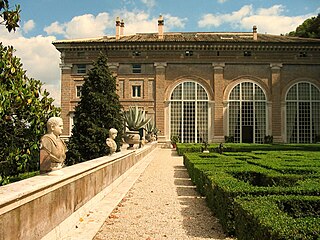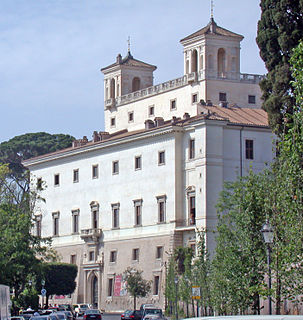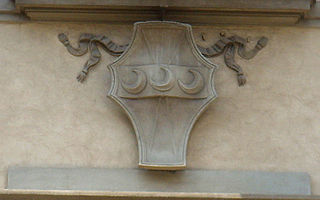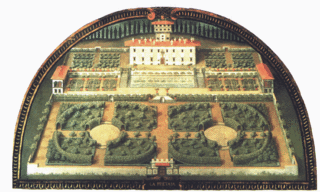
Villa Madama is a prominent rural house or villa built during the Renaissance.

Caprarola is a town and comune in the province of Viterbo, in the Lazio region of central Italy. The village is situated in a range of volcanic hills known as the Cimini Mounts.

Michelozzo di Bartolomeo Michelozzi (1396–1472) was an Italian architect and sculptor. Considered one of the great pioneers of architecture during the Renaissance, Michelozzo was a favored Medici architect who was extensively employed by Cosimo de' Medici. He was a pupil of Lorenzo Ghiberti in his early years and later collaborated with Donatello.

The French Academy in Rome is an Academy located in the Villa Medici, within the Villa Borghese, on the Pincio in Rome, Italy.

Giuliano da Sangallo was an Italian sculptor, architect and military engineer active during the Italian Renaissance. He is known primarily for being the favored architect of Lorenzo de' Medici, his patron. In this role, Giuliano designed a villa for Lorenzo as well as a monastery for Augustinians and a church where a miracle was said to have taken place. Additionally, Giuliano was commissioned to build multiple structures for Pope Julius II and Pope Leo X. Leon Battista Alberti and Filippo Brunelleschi heavily influenced Sangallo and in turn, he influenced other important Renaissance figures such as Raphael, Leonardo da Vinci, his brother Antonio da Sangallo the Elder, and his sons, Antonio da Sangallo the Younger and Francesco da Sangallo.

Palazzo Strozzi is a palace in Florence, Italy.

Luca Pitti (1398–1472) was a Florentine banker during the period of the republic presided over by Cosimo de' Medici. He was a loyal friend and servant to the Medici and the republic. He was awarded a knighthood, and received lavish presents from both the Signory of Firenze and the Medici family as a reward for helping maintain the government during the last years of Cosimo's rule when Cosimo was too old and feeble to maintain power alone.

Strozzi is the name of an ancient Florentine family, who like their great rivals the Medici family, began in banking before moving into politics. Until its exile from Florence in 1434, the Strozzi family was by far the richest in the city, and was rivaled only by the Medici family, who ultimately took control of the government and ruined the Strozzi both financially and politically. This political and financial competition was the origin of the Strozzi-Medici rivalry. Later, while the Medici ruled Florence, the Strozzi family ruled Siena, which Florence attacked, causing great animosity between the two families. Soon afterwards, the Strozzi married into the Medici family, essentially giving the Medici superiority.

The Villa Medici is a Mannerist villa and an architectural complex with a garden contiguous with the larger Borghese gardens, on the Pincian Hill next to Trinità dei Monti in Rome, Italy. The Villa Medici, founded by Ferdinando I de' Medici, Grand Duke of Tuscany and now property of the French State, has housed the French Academy in Rome since 1803. A musical evocation of its garden fountains features in Ottorino Respighi's Fontane di Roma.

Poggio a Caiano is a town and comune in the province of Prato, Tuscany region Italy. The town, birthplace of Philip Mazzei, lies 9 kilometres (6 mi) south of the provincial capital of Prato.

Isabella Romola de' Medici was the daughter of Cosimo I de' Medici, first Grand Duke of Tuscany, and Eleonora di Toledo. She was raised and educated in a humanist manner with her siblings, including Francesco de' Medici who succeeded their father as the Grand Duke of Tuscany. To secure a relationship with the powerful Roman Orsinis, Isabella's father arranged her marriage to Paolo Giordano I Orsini when she was 16. She remained in her father's household after her marriage, giving her an unusual degree of independence for a woman of her period. Following the death of her father, Isabella was probably murdered, with the complicity of her husband and brother, and in retribution for her relationship with Paolo Giordano's cousin Troilo Orsini.

Spagna is an underground station on Line A of the Rome Metro, which was inaugurated in 1980. It is situated in the rione Campo Marzio and is named after the nearby Piazza di Spagna.

Giusto Utens or Justus Utens was a Flemish painter who is remembered for the series of Medicean villas in lunette form that he painted for the third grand duke of Tuscany, Ferdinando I, in 1599–1602.

The Villa Medicea di Cafaggiolo is a villa situated near the Tuscan town of Barberino di Mugello in the valley of the River Sieve, some 25 kilometres north of Florence, central Italy. It was one of the oldest and most favoured of the Medici family estates, having been in the possession of the family since the 14th century, when it was owned by Averardo de' Medici. Averardo's son, Giovanni di Bicci de' Medici, is considered to be the founder of the Medici dynasty.

The Medici villas are a series of rural building complexes in Tuscany which were owned by members of the Medici family between the 15th century and the 17th century. The villas served several functions: they were the country palaces of the Medici, scattered over the territory that they ruled, demonstrating their power and wealth. They were also recreational resorts for the leisure and pleasure of their owners; and, more prosaically, they were the centre of agricultural activities on the surrounding estates. In 2013, the Medici villas were added to UNESCO's World Heritage list.

The Madonna of Palazzo Medici-Riccardi is a painting by the Italian Renaissance artist Filippo Lippi. It is housed in the Palazzo Medici-Riccardi of Florence, central Italy.

The Casino Mediceo di San Marco is a late-Renaissance or Mannerist style palace located on Via Cavour number 57 and via San Gallo in Florence, region of Tuscany, Italy.

Medici is an Italian-British historical drama created by Frank Spotnitz and Nicholas Meyer. The series was produced by Italian Lux Vide and Rai Fiction in collaboration with Frank Spotnitz production tag, Big Light Productions.
















